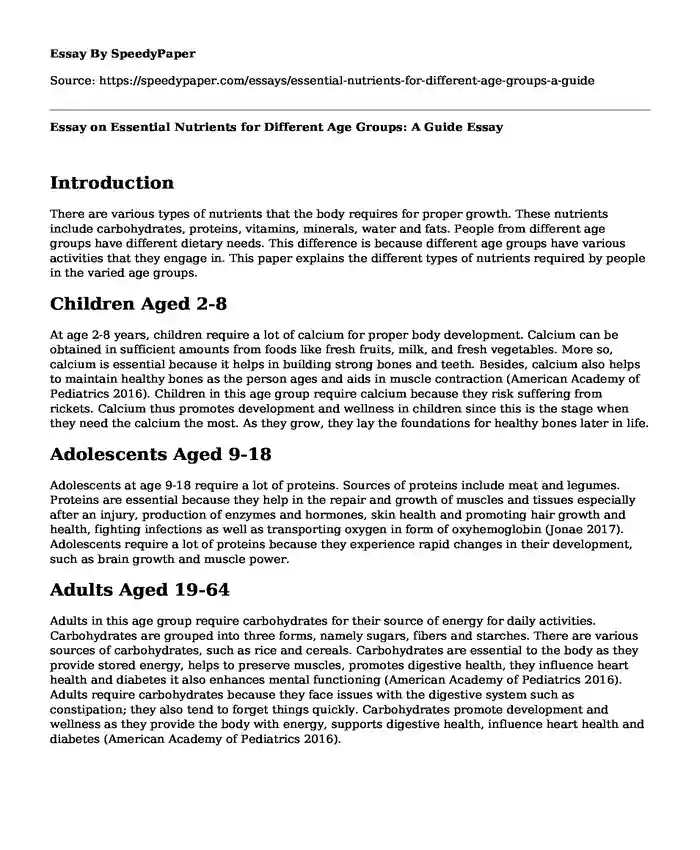
| Type of paper: | Essay |
| Categories: | Food Healthcare Nutrition |
| Pages: | 3 |
| Wordcount: | 709 words |
Introduction
There are various types of nutrients that the body requires for proper growth. These nutrients include carbohydrates, proteins, vitamins, minerals, water and fats. People from different age groups have different dietary needs. This difference is because different age groups have various activities that they engage in. This paper explains the different types of nutrients required by people in the varied age groups.
Children Aged 2-8
At age 2-8 years, children require a lot of calcium for proper body development. Calcium can be obtained in sufficient amounts from foods like fresh fruits, milk, and fresh vegetables. More so, calcium is essential because it helps in building strong bones and teeth. Besides, calcium also helps to maintain healthy bones as the person ages and aids in muscle contraction (American Academy of Pediatrics 2016). Children in this age group require calcium because they risk suffering from rickets. Calcium thus promotes development and wellness in children since this is the stage when they need the calcium the most. As they grow, they lay the foundations for healthy bones later in life.
Adolescents Aged 9-18
Adolescents at age 9-18 require a lot of proteins. Sources of proteins include meat and legumes. Proteins are essential because they help in the repair and growth of muscles and tissues especially after an injury, production of enzymes and hormones, skin health and promoting hair growth and health, fighting infections as well as transporting oxygen in form of oxyhemoglobin (Jonae 2017). Adolescents require a lot of proteins because they experience rapid changes in their development, such as brain growth and muscle power.
Adults Aged 19-64
Adults in this age group require carbohydrates for their source of energy for daily activities. Carbohydrates are grouped into three forms, namely sugars, fibers and starches. There are various sources of carbohydrates, such as rice and cereals. Carbohydrates are essential to the body as they provide stored energy, helps to preserve muscles, promotes digestive health, they influence heart health and diabetes it also enhances mental functioning (American Academy of Pediatrics 2016). Adults require carbohydrates because they face issues with the digestive system such as constipation; they also tend to forget things quickly. Carbohydrates promote development and wellness as they provide the body with energy, supports digestive health, influence heart health and diabetes (American Academy of Pediatrics 2016).
Older Adults Over 65 Years
Older adults require vitamins, especially vitamin D. Sources of vitamin D includes eggs and fish such as salmons. Vitamin D is vital because it maintains healthy bones, prevents falls in older people, reduces the risk of cancer such as colon cancer and breast cancer. Also, vitamin D protects against heart diseases, improves lung function, improves moods, helps to fight infections and others (Ware 2019). Older adults require vitamin D because they experience osteoporosis which makes the bones thin and can easily fracture. Vitamin D also helps to maintain their physical independence and mobility and reduces the risk of suffering from diabetes and some cancers like bone and blood cancer (Wagerer 2015). This proves that vitamin D is vital in development and wellness of the old as it enables older people to avoid specific health issues such as some kinds of cancer and diabetes.
Conclusion
In conclusion, the six nutrients are seen to be very beneficial to the development and growth of the human body. They are found in the different kinds of food that people consume daily. These nutrients are essential to the wellness of our growth as they help proper growth and functioning of our bodies. They also help keep people healthy and free of certain diseases such as cancer diabetes in older adults, bone weakness in children, helps in body changes in adolescents and provides energy in adults.
References
American Academy of Pediatrics. (2016). Childhood Nutrition. Healthy children. Org. Retrieved 18 July 2020, from https://www.healthychildren.org/English/healthy-living/nutrition/Pages/Childhood-Nutrition.aspx
Jonae.F. (2017) The importance of Proteins for Growing Teens. How to adult. Retrieved 18 July 2020, from https://howtoadult.com/importance-protein-growing-teens-15951.html
Wagerer. J. (2015). 5 Reasons Vitamin D is a must-have for Seniors. Senior Living Blog. Retrieved 18 July 2020, from https://www.aplaceformom.com/blog/3-19-14-seniors-vitamin-d-deficiency/#:~:text=It%20helps%20the%20body%20absorb,weakness%20and%20possible%20skeletal%20deformity.
Ware. M (2019). Vitamin D: Benefits, Deficiency, Sources, and Dosage. Medicalnewstoday.com. Retrieved 18 July 2020, from https://www.medicalnewstoday.com/articles/161618#deficiency.
Cite this page
Essay on Essential Nutrients for Different Age Groups: A Guide. (2023, Oct 15). Retrieved from https://speedypaper.com/essays/essential-nutrients-for-different-age-groups-a-guide
Request Removal
If you are the original author of this essay and no longer wish to have it published on the SpeedyPaper website, please click below to request its removal:
- Introduction to Public Health, Free Essay Sample
- The Non-Acceptance of Psychiatry in Saudi Arabia, Free Essay for Students
- Essay Sample on the Impacts and Treatment for Synthetic Designer Drugs
- Problem 10.2
- Essay Sample on Vaccination for Children
- Essay Example. African American Issues
- My Proposal: Strengthening Bakersfield Elderly-Employee Relationships via Team-Building - Essay Sample
Popular categories




